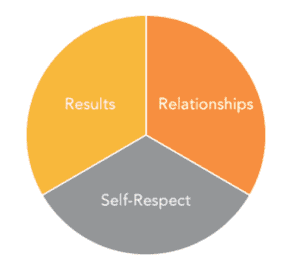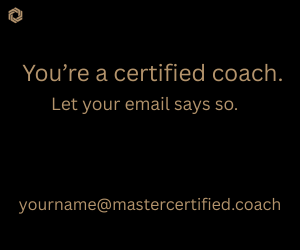Communication is the transfer of information from one person to another in order to produce greater understanding. It is my attempt to share with you my thoughts, feelings and information, and it is your attempt to understand me. However, due to differences in culture, language, generations and more, communication is not easy. So, how do we strengthen the social fabric that is needed for the transmission of successful communication?
 When it comes to building rapport and creating sustainable, long-term relationships, respectful assertiveness is key. Assertiveness allows you to balance the three key elements of communicating for respect: results, relationships and self-respect.
When it comes to building rapport and creating sustainable, long-term relationships, respectful assertiveness is key. Assertiveness allows you to balance the three key elements of communicating for respect: results, relationships and self-respect.
Results
Respectfully negotiating to obtain results is an artform. It is much more common for a person to bulldoze others in an aggressive warpath to getting what they want.
When I coach clients on obtaining results, I share a framework called, “I think, I want, I feel.” For example, a client might schedule a meeting with their supervisor to request a pay raise. Using the “I think, I want, I feel” model, they might form the following script:
“I think that my job performance over the last four years, coupled with my credentials and education, merit consideration for a raise. I feel appreciation for the role I am in and my colleagues, and I would like to stay in this organization long term. I want you to consider me for a salary increase.”
A common question I ask once the script is in place is, “What possible objections and rebuttals might you face?” I also ask if there is any room for compromise if the other party simply cannot or will not fulfill the request.
Relationships
One of the most common ways leaders unknowingly disrespect their people is by criticizing them in an attempt to produce results. A more respectful and assertive way is to use validation, which demonstrates listening and understanding.
When a client is struggling with relationships, I ask them how they can positively motivate others. What is the other person doing right? Can the client acknowledge the other party is trying their best? Can the client normalize others’ difficult emotions and stressful situations by saying, “That would be hard for me also?”
Getting results while balancing relationships is dynamic, especially when you combine these two elements in a way that allows you to keep your self-respect.
Self-Respect
Self-respect is sticking to your values and beliefs and not apologizing for your opinion, who you are, how you see the world, or what you feel.
While getting results employs the tool of “I think, I feel, I want” and keeping relationships utilizes validation, the key to self-respect is boundaries.
Boundaries are an invisible door between you and other people. If the door comes off the hinges, people can come through the door even when you do not want them to. Similarly, if the door is closed and bolted shut, you cannot allow people in.
The trick is to decide for whom, and when, you will open the door. Boundaries are a highly individual process of deciding who are the “right” people and what is the “right” information to let in while keeping unhelpful and unhealthy things away.
When I work with clients to set boundaries, I first clarify the limit they would like to set through powerful questioning. Then, I facilitate their writing of a script in which they express their boundary to the other party in a clear, calm and concise way. Finally, we discuss how the client will enforce the boundary when the other party violates it.
For example, a client who has an addicted co-worker might state, “If you call me late at night while under the influence again, I will need to report the incident to HR.”
Application of Communicating for Respect
When I am working with a client on communication skills, I help them identify what their primary style is: aggressive, passive, passive-aggressive or assertive. If assertiveness is not their natural default, I ask them questions to reflect on the pros and cons of their natural style versus a more assertive style.
As the client begins to practice an assertive style that respects both themself and others, I help them identify which aspect of respectful communication they are strongest and weakest in: relationships, results and self-respect.
Third, we use the tools discussed in this article to improve identified areas of growth: “I think, I feel, I want” for results; validation for relationships; and boundaries for self-respect.
These three steps generally improve clients’ communication skills. They find that when respect is present in a relationship, each person can assume the best about the other without having to question motivations. Both parties feel the other has qualities that add value to their life or career. And each party treats the other with dignity in uplifting, affirming dialogues.
Disclaimer
The views and opinions expressed in guest posts featured on this blog are those of the author and do not necessarily reflect the opinions and views of the International Coach Federation (ICF). The publication of a guest post on the ICF Blog does not equate to an ICF endorsement or guarantee of the products or services provided by the author.
Additionally, for the purpose of full disclosure and as a disclaimer of liability, this content was possibly generated using the assistance of an AI program. Its contents, either in whole or in part, have been reviewed and revised by a human. Nevertheless, the reader/user is responsible for verifying the information presented and should not rely upon this article or post as providing any specific professional advice or counsel. Its contents are provided “as is,” and ICF makes no representations or warranties as to its accuracy or completeness and to the fullest extent permitted by applicable law specifically disclaims any and all liability for any damages or injuries resulting from use of or reliance thereupon.
Authors
Post Type
Blog
Audience Type
Coach Educators, Experienced Coaches, External Coaches, ICF Chapter Leaders, Internal Coaches, New Coaches, Professional Coaches, Team and Group Coaches
Topic
Coaching Toolbox, Discover - Your Coaching Career
Related Posts
How Psychology and Supervision Evolve Coaching
As the coaching profession continues to grow and mature, one question is…
How Conscientious Inclusion Can Improve Your Coaching
Coaching continues to evolve as the world becomes more interconnected, multicultural, and…
The Coaching Trap: When Empathy Becomes Exhaustion
Prepare yourself for the fact that this will not be about you…








